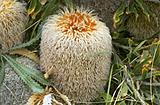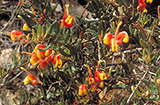|
[Front Page] [Features] [Departments] [Society Home] [Subscribe]

History of Botanical Nomenclature
Barry Kemp
If you find it hard to remember, spell or pronounce scientific names, you are not alone but it sometimes helps if you understand how the present system developed.
Names are just labels we use to ensure we are understood when we communicate. The beginnings of language can be seen in birds which have a 'danger' call, a territorial call, etc, but humans were not satisfied with this, they wanted to be more specific and share more information, so individual food plants etc needed their own distinctive grunt, whine, whatever (mothers will get the drift!).
The early Egyptians and Greeks named many food plants and others with medicinal properties. One of the most important early works was by the Greek, Theophrastus, who recognized the difference between what we now call monocotyledons and dicotyledons. His book was in use for many centuries, as was the work of Dioscorides, a physician of the first century AD, who wrote mainly about medicinal plants and who recognized groups we now call families. Since many languages developed, often a plant was given a different name in several different languages. This was OK if you stayed at home but trade presented a problem. The Romans weren't too fussy about what you called it, they sent a lot of fierce men to take it from you or make you grow it for them. They imposed their 'civilization' on a very large area of the 'known' world of the time. Their influence was such that their language (Latin) became the way that learned men communicated across other language barriers. (Until fairly recently, if you were lucky enough to receive an education, Latin was one of the first things you learnt).
Many present day plant names stem from Roman times (including some 'common' ones). Before the invention of printing, knowledge about plants, apart from word of mouth, was recorded in hand written books, usually done by monks, physicians or a learned servant of a more enlightened ruler. Illustrations were copied and re-copied until they bore little resemblance to the original. Initially, a single name would do, e.g. Rubus (the bramble) but since this may cover a wide variety of plants, additional qualifying names had to be added, so that the names meant "the bramble with the large leaves and black, juicy fruit" or something similar. Since there were no widely accepted rules, and communication often took years, it would have been fairly confusing, even if you could read, which wasn't very likely. There was the added complication that anyone seen to be challenging long-accepted dogma was likely to come to a very sticky end!
There was, then, not a lot of botanical progress until about the 16th century, when a number of useful works were printed, mainly 'herbals', often with woodcut engravings. Attempts were made to classify plants, and descriptions were published, but the importance of flowers and fruits remained unrecognized. One author declared that plants had a soul, located at the junction of stem and roots! In 1620, Swiss Caspar Bauhin introduced the concept of genus and species later refined by Linnaeus. German botanist Camerarius was the first to recognize the sexual nature of plants.
The man generally credited with creating an orderly system for naming plants is Swedish botanist, Carl Linné. In 1753 he published a book whose title is usually abbreviated to Species Plantarum, written in Latin as was the custom of the time (so I wouldn't follow very much of it), but it set the pattern, which we follow today with a few changes. He firmly applied the binomial system, where a plant name has two parts.....
- a Genus name e.g. Rubus and
- a Species name which is a kind of qualifier
.....so the full name is like a noun followed by an adjective as in Rubus parvifolius - literally, the bramble with the small leaves.
Linné, ( who latinized his name to Linnaeus) published a large number of plant names, with a detailed description of each. Since then, for a new plant name to be considered valid, it must first be published with a description in Latin (then said to be 'described'), which was accepted by botanists of any nationality as a sort of neutral territory, but, which is becoming a problem in these times when few botanists learn Latin. However, scientists tend to be fairly conservative and suspicious of one another's work, so change could take a long time. And can you imagine what the French would say if English was declared the language to be used!
Linnaeus did not know about evolution; at the time there was a general belief in a 'Grand Design' into which all things must fit. His classification depended a lot on things like the number of petals or stamens, so there has been a fair amount of re-organization as true relationships are sought, and people like Robert Brown introduced changes like the Family level of classification first noticed by Dioscorides and called 'Natural Orders' by Brown.
| |
Changes...Changes.... |
| |
Strict application of botanical rules can be confusing to non-botanists - but there is logic there even if it may not be immediately apparent.
An example is the changes that have occurred to the well-known golden everlasting daisy. For many years this plant was known by the name Helichrysum bracteatum. However, research into the status of the genus Helichrysum in Australia in the 1980s-1990s resulted in the transfer of many Australian helichrysums to other genera. As a result. Helichrysum bracteatum became Bracteantha bracteata. More recent research, however, has discovered that the name Bracteantha, published in 1991, is antedated by the name Xerochrysum, published by a Russian botanist in 1990. As a result, all the Bracteantha names must change to Xerochrysum.
And so, Bracteantha bracteata has now become Xerochrysum bracteatum.

Click for a larger image
Another example of multiple name changes, resulting from a check of Callistemon type specimens, is described in A Beginner's Botany, p.4 (see "References"). |
As already mentioned, Latin was the language used for communication between scholars of European background, even when it was no longer an everyday language, so for botanical terminology to develop, it was necessary to borrow words from other languages, particularly Greek, and to give new meanings to old words, e.g. corolla means 'a little crown or garland' in classical Latin, but is used as the collective term for petals in the botanical sense. New words were also coined, like sepal and perianth, although there was sometimes disagreement about their definition.
The validity of a plant name depends on its author having published a description. In the early history of Australia, all formal naming of indigenous plants was done overseas, mainly in Europe. Since travel and communication were very slow, a certain amount of duplication was inevitable. Some recent name changes have resulted from the discovery of an earlier published name for a particular plant, or simply that we have been applying a name to the wrong plant.
When a plant is named, a pressed specimen, known as the 'type', must be lodged with a recognized herbarium so that botanists can refer back to the original material.
Further complication arises because of the considerable variation, which can occur in a particular plant species, and the difficulty in deciding when a variation warrants a new name. Botanists working on such things are known as 'splitters' or 'lumpers', i.e they split groups presently included under one name, or lump several under one name. This continues to be another reason for new and changed names.
The origin of some plant names is lost in the mists of time, many simply described as being of Greek or Roman origin. Some sort of meaning or reason for those first published since Linnaeus' time can usually be found. Commemorative names have often been used, like Banksia or Dillwynia, both named after botanists, or Hakea victoria, the genus name after a wealthy patron of botany and the species name after Queen Victoria. Sometimes the name of the discoverer of the plant is used, e.g. the genus Alexfloydia.
 | |
 | |
Banksia (top)
named after Sir Joseph Banks
Dillwynia (bottom)
named after Lewis Dillwyn
Click for a larger image | |
The most useful names tell us something about the plant, although this is sometimes a little obscure. It is not difficult to guess that Leptospermum novae-angliae is the New England tea-tree. (Leptospermum results from joining two Greek words meaning 'fine' and 'seed'). Words describing habitat e.g. littoralis (from the coastal zone) or alpina (obvious) are often used for species names. A plant's habit is described in names like arborescens (tending to grow to tree size) or prostrata (prostrate or ground hugging). Melaleuca means black and white, believed to be a reference to the appearance of recently burnt paperbarks with peeling bark. Eucalyptus neglecta is meant to suggest a previously overlooked species.
The many different terms used to describe the vestiture (hairs, scales etc) on a plant provide a ready source of material for specific names like villosa (with long, shaggy hairs), lanigera (woolly) and pubescens (weak, soft hairs). Leaf shape may be used, e.g. peltata (attached at a point away from the margin) or obcordata (reverse heart-shaped). In some cases the organ referred to is not immediately obvious - is it the leaves that are obcordate or could it be the petals? Sometimes, they have been kinder to us, as in Leptospermum minutifolium, clearly the leaves are small. Not so kind was the author of the name Adenanthos ileticos, the species name derived from the Greek ileticos, meaning 'wriggle', so if you know Greek and are good at cryptic crosswords, you may deduce that it was named after John Wrigley, the well-known authority on Australian native plants!
| |  |
| | Grevillea alpina
Grevillea - after Charles Francis Greville
alpina - because of the alpine habitat of the type form
Click for a larger image |
Name endings are subject to the complicated rules of Latin grammar. I have a three-page explanation of how this applies to botany and by the time I get to page three, my gyro's have toppled and I decide I will take them as they come.
When a plant is transferred to a different genus, the species name must follow unless it is already in use in the new genus, but sometimes the rules of grammar require a different ending, e.g Helichrysum bracteatum became Bracteantha bracteata and then Xerochrysum bracteatum!
There will be more on the meaning of plant names in the next issue of Australian Plants online - but if you are interested in learning more about this topic, Stearn's Botanical Latin, although rather heavy in more than one sense, contains a wealth of information about such things, as well as a little history.
References
Stearn, T.W. , Botanical Latin
Hutchinson, J. & Melville, R., The Story of Plants
Kemp, B., A Beginner's Botany. Coffs Harbour Group, Australian Plants Society (NSW)
From the newsletter of the Coffs Harbour Group of the Australian Plants Society (NSW), issues 34 and 35.

[Front Page] [Features] [Departments] [Society Home] [Subscribe]
Australian Plants online - June 2002
Association of Societies for Growing Australian Plants
|